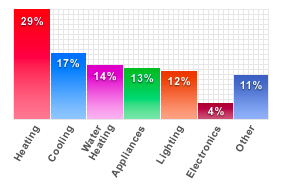Why the EPA took its Energy Star label off thermostats to save you money at home

We all know the star. The Environmental Protection Agency and Department of Energy’s joint Energy Star program now has 60 product categories that can earn the logo, from cordless phones to ceiling fans. Established to reduce greenhouse gas emissions and pollutants caused by the inefficient use of energy, and to make it easy for us to identify and purchase energy-efficient products, Energy Star is now a logo in high demand in stores and homes alike.
But according to EPA’s Energy Star Brand Manager Maria Vargas, consumers need to look past appliances and toward heating and cooling if they really want to be an environmental star. I talked to Vargas last week.
What’s the biggest misconception about Energy Star products?
There’s such a fundamental disconnect between understating how the energy we use in our homes is connected to climate change. If you ask people the biggest energy consumer in their home, most say refrigerator. They don’t realize over half goes to heating and cooling. Also, most people don’t realize that our houses create twice the greenhouse gas emissions of the average car.
I think when most of us consider Energy Star products, we think of appliances.

People think it’s all about appliances, but they are only about 13 percent of a home’s energy bill. Appliances are important, especially refrigerators, which are on 24/7, but if you really want to make an impact on your carbon footprint, it’s all about heating and cooling.
What’s an example?
It’s not just the widgets you buy but how you use them. A great example is a programmable thermostat. We actually took the Energy Star label off the programmable thermostat because it’s not efficient by itself. It’s designed to allow you to have your house hotter or colder in the summer or winter when you're not there. They’re about $50, and you can save about $180 a year on your energy bill.
What are some new Energy Star products?
We’ve done the big-ticket items, so we’re now looking at coffee makers, commercial fryers, commercial ice makers, battery chargers, microwaves. The fun thing about our job is that as human beings, our lives change. Game consoles are ubiquitous now, so those are on our list to look at. Things that used to be non-existent—like digital picture frames or cell phone chargers—are a growing piece of the pie.
What about TVs?
TVs are a really interesting story. For years, we had an Energy Star level set for TVs that was really about how you work with manufactures for energy consumption when they were turned off (draining electricity from the plug). We were spending $1 billion a year on energy just when TVs were turned off. All of a sudden, we started using TVs for things other than watching TV—for recording shows, playing games, showing pictures. In addition, the size of these things were getting bigger and bigger. So we set a spec for televisions that tested them when they were turned off as well as when they were turned on. Our current spec was set in November 2008, and we’ll have new ones in 2010 and 2012.
So what’s the rule with computers? I keep mine on all the time. Is that terrible?
This program started because we walked around and saw so many computers on in office buildings when people weren’t using them. Computers were our first Energy Star product in 1992. The key thing with computers is the setting. Make sure the power management function is enabled, so it goes to sleep when you’re not there.
When we work with a manufacturer, we make sure they ship it enabled—so the default is that the energy saving feature is on, and you have to take action to be environmentally hostile. The ideal thing would be to turn it off, but I’m an idealist; and if I [turned it off] in my office every time, it would drive me crazy.
Click here to read a post about the Department of Energy's Office of the General Counsel.
This post was originally published on Smartplanet.com
